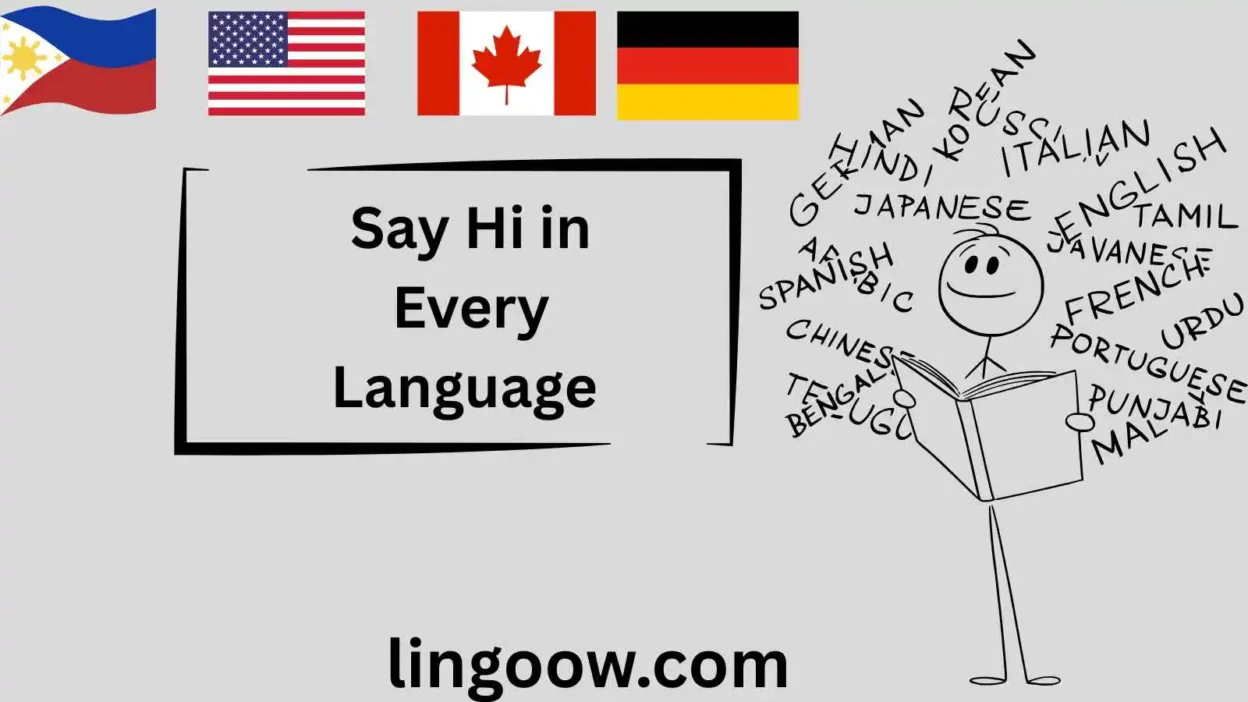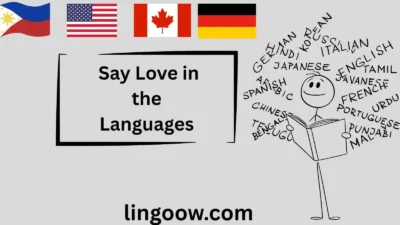Have you ever wished you could say Hi to anyone, anywhere in the world? Whether you’re a traveler, a language lover, or someone who simply enjoys connecting with new people, learning greetings in different languages instantly makes communication friendlier and more meaningful.
In this guide, I’ll walk you through how to say Hi in dozens of languages—simple, quick, and easy to remember.
No confusing grammar, no long lessons. Just practical words you can use right away when meeting someone new. So let’s explore the world together, one friendly “Hi” at a time!
Quick Reference Table
| Language | How to Say “Hi/Hello” | Pronunciation (approx.) | Cultural Note |
| French | Bonjour | bon-ZHOOR | Literally “good day” – you say it once when you arrive, never repeated. |
| Spanish | Hola | OH-la | Super casual; used with strangers and best friends alike. |
| Italian | Ciao | CHOW | One word for both hello and goodbye – pure efficiency! |
| German | Hallo / Guten Tag | HAL-lo / GOO-ten TAHK | “Guten Tag” is more formal; “Hallo” is everyday. |
| Portuguese | Olá | oh-LAH | The accent mark makes it sing. |
| Dutch | Hallo / Dag | HAL-lo / DACH | “Dag” means “day” and works for hello and goodbye. |
| Russian | Привет (Privet) | pree-VYET | Informal; use Здравствуйте (Zdravstvuyte) with elders or officials. |
| Mandarin Chinese | 你好 (Nǐ hǎo) | nee-HOW | Literally “you good?” – always said with a smile. |
| Japanese | こんにちは (Konnichiwa) | kon-nee-chee-WAH | Literally “this day is…” – a wish for a good day. |
| Korean | 안녕하세요 (Annyeonghaseyo) | ann-yong-ha-say-yo | Bow slightly; the deeper the bow, the more respect. |
| Hindi | नमस्ते (Namaste) | nah-mah-STAY | “I bow to the divine in you” – hands pressed together. |
| Arabic | مرحبا (Marhaban) / السلام عليكم | mar-ha-ban / as-salaam alaikum | “Peace be upon you” – the standard Muslim greeting across 20+ countries. |
| Swahili | Jambo / Habari | JAHM-bo / ha-BAH-ree | “Jambo” is tourist Swahili; locals prefer “Habari” (“news?”). |
| Zulu | Sawubona | sah-woo-BOH-nah | Literally “I see you” – profound person-to-person acknowledgment. |
| Hawaiian | Aloha | ah-LO-ha | Means love, compassion, hello, goodbye… basically everything good. |
| Māori (New Zealand) | Kia ora | kee-ah OR-ah | Also means “be well/be healthy” – a wish for life. |
| Inuit (Greenland) | Aluu | ah-LOO | Simple and warm, even in -40°C! |
| Cherokee | ᎣᏏᏲ (Osiyo) | oh-SEE-yoh | Often accompanied by a handshake or hug in modern use. |
| Icelandic | Hæ / Góðan dag | HYE / GO-thahn dahg | “Hæ” is the casual phone greeting – one syllable! |
| Thai | สวัสดี (Sawasdee) | sa-wat-DEE | Said with a graceful wai (hands in prayer position). Gender changes the ending slightly. |
European Languages
Europeans love rules, and greetings are no exception.
The French won’t dream of skipping Bonjour when entering a shop (it’s borderline rude). Italians throw Ciao around like confetti. Spaniards greet with Hola and immediately follow with two kisses on the cheek—even with strangers in some regions. Germans switch between casual Hallo and the more proper Guten Tag depending on time of day and hierarchy.
In colder Nordic countries, a simple nod and Hej (Swedish) or Moi (Finnish) is enough—you don’t need to invade personal space to show warmth.
Asian Languages
Asia teaches us that “hello” is never just sound—it’s posture, tone, and timing.
Japanese Konnichiwa is only used in the daytime; say Ohayō gozaimasu too late and you’ll get polite giggles.
Koreans adjust honorifics instantly based on age—one wrong level and you’ve accidentally insulted grandma.
In India, Namaste plus prayer hands is both greeting and blessing; touching feet of elders takes it deeper.
In Thailand and Cambodia, the higher you raise your wai, the more respect you show. Even the Arab world’s As-salaam alaikum is a mini prayer for peace every single time you meet someone.
African Languages
In many African cultures, greeting isn’t a formality—it’s communion.
Zulu Sawubona (“I see you”) demands the reply Yebo, sawubona (“Yes, I see you too”). In Yoruba (Nigeria, Benin), you’ll hear long chains of greetings asking about family, health, work, and the journey—because the person is more important than the clock.
Swahili’s Habari gani? (“What news?”) invites storytelling right from hello. In Wolof (Senegal), the response to Salaam aleekum can go on for minutes—each line a deeper wish for peace and prosperity.
Indigenous & Island Languages
For many indigenous peoples, greeting a person means greeting the place and the ancestors too.
Hawaiian Aloha is a whole philosophy: to live with love and respect. Māori Kia ora welcomes you into the whānau (extended family). Navajo say Yá’át’ééh—a word so sacred it’s also used to greet the sunrise.
In Inuit communities across the Arctic, a simple Aluu or raised eyebrows can mean hello when faces are wrapped against the cold. These aren’t just words; they’re contracts of care between people and the earth.
How “Hello” Evolved Through History
The English “hello” is actually quite young—it only became a greeting after the telephone was invented in the 1870s (people needed a way to answer the new ringing machines). Before that, we said “Hail!” or “Good day.”
The French Bonjour dates back to the 12th century, literally wishing someone a day full of goodness.
Arabic’s salaam traces directly to ancient Semitic roots over 3,000 years old. Sanskrit Namaste appears in the Rig Veda (1500 BCE). Even the telephone greeting “Ahoy!” was Alexander Graham Bell’s preferred choice (thankfully we stuck with “hello”).
Proverbs & Sayings About Greeting
- Italy: “Chi non saluta, non è persona” – Who doesn’t greet isn’t a person.
- Japan: “Hajimemashite yoroshiku onegaishimasu” – The full first-meeting phrase that literally means “Please treat me well from now on.”
- Zulu: “Umuntu ngumuntu ngabantu” – A person is a person through other people (greeting is the first step).
- Hawaii: “Aloha is the joyful sharing of life energy in the present.”
- Morocco: “A smile is the universal welcome.” (Even if you butcher the Arabic!)
Frequently Asked Questions
Why do so many languages have similar-sounding greetings?
Many trace back to Proto-Indo-European roots (sal- for health/peace) or to religious phrases (shalom, salaam, peace).
What’s the oldest known greeting?
Sumerian cuneiform tablets from 2000 BCE show the phrase “Peace upon you.”
Is it ever rude to say “hello” in another culture?
Yes—staring while saying Sawubona in Zulu culture can feel aggressive. In Japan, shouting Konnichiwa across a quiet train car is a no-no.
The Final:
Every language ever spoken has found a way to say, “I’m here. You’re here. Let’s be human together.”
Some say it with bows, some with hugs, some with long poetic inquiries about your goats and your grandmother. But every single one is a door swinging open So here’s my ask:
Drop into the comments and teach us how YOU say hello in your language or dialect. Write it in the original script if you can, add the pronunciation, and tell us the story behind it. Because every time someone learns a new way to say “hi,” the world gets a little smaller—and a lot warmer.




